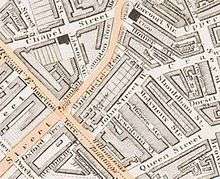Crawford Place



Crawford Place is a street in the Marylebone district of the City of Westminster, London. The street was developed in the first decade of the 1800s and was original known as John Street West.
Location
The street runs from Edgware Road in the west to the junction of Homer Row, Shouldham Street, and Crawford Street in the east. Brendon Street, Cato Street, and Molyneux Street run south from Crawford Place. Watson's Mews is off the north side of Crawford Place.
History
The street and the adjacent streets to the east of Edgware Road were laid out in the first decade of the 1800s as an area of "fourth rate" terraced housing. Greenwood's map of 1830 shows it marked as John Street West.[1] It is now known as Crawford Place and there are several streets in the area named after Tarrant Crawford, a property in Dorset owned by the Portman family who owned much of the land in Marylebone.[2]
The street is mostly within the City of Westminster's Molyneux Street Conservation Area.[3]
Buildings
On the north side of the street, Abrar House, on the corner with Homer Row, is the home on the second floor of the High Commission for Antigua & Barbuda in London.[4] The third floor of Abrar House is the High Commission of Belize in London.[5] Also on the north side are, from east to west, the rear of the Roman Catholic Church of Our Lady of the Rosary, Marylebone, the Windsor Castle public house, The Christian Union Alms-Houses (rebuilt 1899),[6] and the Crawford Place mansion block at No. 11.[3]
On the south side of the street are The Larrick public house on the corner with Shouldham Street, the modernist Elliott House (1939) between Molyneux Street and Cato Street, the Lord Wargrave public house on the corner with Brendon Street, and the Central London Seventh-Day Adventist Church at the eastern end of the street.[7]
The Windsor Castle and The Larrick public houses are not listed buildings with Historic England but are designated buildings of merit within the Molyneux Street conservation area.[1]
The remainder of the street is a mix of terraced houses, small shops and modern buildings.
References
- 1 2 Molyneux Street Conservation Area Audit. City of Westminster, London, 2002.
- ↑ Hibbert, Christopher; Ben Weinreb; John Keay; Julia Keay. (2010). The London Encyclopaedia. London: Pan Macmillan. p. 217. ISBN 978-0-230-73878-2.
- 1 2 Map of Molyneux Street Conservation Area. City of Westminster, 2007. Retrieved 23 September 2015.
- ↑ Home. Antigua and Barbuda High Commission. Retrieved 21 September 2015.
- ↑ Home. Belize High Commission London. Retrieved 21 September 2015.
- ↑ Christian Union Almshouses, 21 Crawford Place. National Archives. Retrieved 24 September 2015.
- ↑ Welcome to Central London Church. Central London Seventh-Day Adventist Church. Retrieved 24 September 2015.
External links
![]() Media related to Crawford Place, London at Wikimedia Commons
Media related to Crawford Place, London at Wikimedia Commons